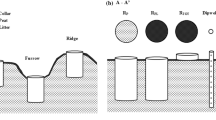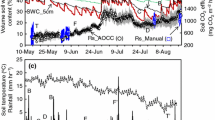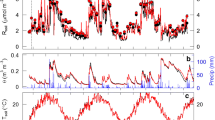Abstract
Rates of soil respiration (CO2 efflux) were measured for a year in a mature Eucalyptus pauciflora forest in unfertilized and phosphorus-fertilized plots. Soil CO2 efflux showed a distinct seasonal trend, and average daily rates ranged from 124 to 574 mg CO2 m−2 hr−1. Temperature and moisture are the main variables that cause variation in soil CO2 efflux; hence their effects were investigated over a year so as to then differentiate the treatment effect of phosphorus (P) nutrition.
Soil temperature had the greatest effect on CO2 efflux and exhibited a highly significant logarithmic relationship (r2 = 0.81). Periods of low soil and litter moisture occurred during summer when temperatures were greater than 10 °C, and this resulted in depression of soil CO2 efflux. During winter, when temperatures were less than 10 °C, soil and litter moisture were consistently high and thus their variation had little effect on soil CO2 efflux. A multiple regression model including soil temperature, and soil and litter moisture accounted for 97% of the variance in rates of CO2 efflux, and thus can be used to predict soil CO2 efflux at this site with high accuracy. Total annual efflux of carbon from soil was estimated to be 7.11 t C ha−1 yr−1. The model was used to predict changes in this annual flux if temperature and moisture conditions were altered. The extent to which coefficients of the model differ among sites and forest types requires testing.
Increased soil P availability resulted in a large increase in stem growth of trees but a reduction in the rate of soil CO2 efflux by approximately 8%. This reduction is suggested to be due to lower root activity resulting from reduced allocation of assimilate belowground. Root activity changed when P was added to microsites within plots, and via the whole tree root system at the plot level. These relationships of belowground carbon fluxes with temperature, moisture and nutrient availability provide essential information for understanding and predicting potential changes in forest ecosystems in response to land use management or climate change.
Similar content being viewed by others
References
Anderson J M 1973 Carbon dioxide evolution from two temperate deciduous woodland soils. J. Appl. Ecol. 10, 361-375.
Anderson J M 1991 The effects of climate change on decomposition processes in grassland and coniferous forests. Ecol. Appl. 1, 326- 347.
Brook R J and Arnold G C 1985 Applied Regression Analysis and Experimental Design. Statistics. Textbooks and Monographs, Vol. 62. Marcel Dekker, New York. 237 p + vii.
Buwalda J G, Fossen M and Lenz F 1992 Carbon dioxide efflux from roots of calamodin and apple. Tree Physiol. 10, 391-401.
Carlyle J C and Than U B 1988 Abiotic controls of soil respiration beneath an eighteen-year-old Pinus radiatastand in south-eastern Australia. J. Ecol. 76, 654-662.
Charley J L and Richards B N 1983 Nutrient allocation in plant communities: mineral cycling in terrestrial ecosystems. InPlant Physiological Ecology IV Vol. 12D. Eds. O L Lange, P S Nobel, C B Osmond and H Ziegler. pp 5-45. Springer-Verlag, Berlin.
Coleman D C 1973 Compartmental analysis of "total soil respiration": an exploratory study. Oikos 24, 361-366.
Cropper W P, Ewel K C and Raich J W 1985 The measurement of soil CO2 evolution in situ. Pedobiologia 28, 35-44.
Diggle P J, Liang K-Y and Zeger S L 1994 Analysis of Longitudinal Data. Clarendon Press, Oxford. 253p + viii.
Edwards N T 1975 Effects of temperature and moisture on carbon dioxide evolution in a mixed deciduous forest floor. Soil Sci. Soc. Am. J. 39, 361-365.
Edwards N T 1982 The use of soda-lime for measuring respiration rates in terrestrial systems. Pedobiologia 23, 321-330.
Edwards N T and Ross-Todd B M 1983 Soil carbon dynamics in a mixed deciduous forest following clear-cutting with and without residue removal. Soil Sci. Soc. Am. J. 47, 1014-1021.
Ellis R C 1969 The respiration of the soil beneath some Eucalyptusforest stands as related to the productivity of the stands. Aust. J. Soil Res. 7, 349-357.
Ewel K C, Cropper W P and Gholz H L 1987 Soil CO2 evolution in Florida slash pine plantations I. Changes through time. Can. J. For. Res. 17, 325-329.
Foster R C 1983 The plant root environment. InSoils: an Australian Viewpoint. pp 673-684. CSIRO Division of Soils, CSIRO, Melboume/ Academic Press, London.
Gordon A M, Schlentner R E and van Cleve K 1987 Seasonal patterns of soil respiration and CO2 evolution following harvesting in the white spruce forests of interior Alaska. Can. J. For. Res. 17, 304- 310.
Haynes B and Gower S T 1995 Belowground carbon allocation in unfertilised and fertilised red pine plantations in northern Wisconsin. Tree Physiol. 15, 317-325.
Hendrickson O Q and Robinson J B 1984 Effects of roots and litter onmineralization processes in forest soil. Plant Soil 80, 391-405.
Holt J A, Hodgen M J and Lamb D 1990 Soil respiration in the seasonally dry tropics near Townsville, North Queensland. Aust. J. Soil Res. 28, 737-745.
Howard P J A 1966 A method for the estimation of carbon dioxide evolved from the surface of soil in the field. Oikos 17, 267-271.
Howard P J A and Howard D M 1979 Respiration of decomposing litter in relation to temperature and moisture II. Microbial decomposition of tree and shrub leaflitter. Oikos 33, 457-465.
Jenkinson D S, Adams D E and Wild A 1991 Model estimates of CO2 emissions from soil in response to global warming. Nature 351, 304-306.
Jorgensen J R and Wells C G 1973 The relationship of respiration in organic and mineral soil layers to soil chemical properties. Plant Soil 39, 373-387.
Keith H 1991 Effects of fire and fertilization on nitrogen cycling and tree growth in a subalpine eucalypt forest. PhD thesis, ANU, Canberra.
Keyes M R and Grier C G 1981 Above-and below-ground net production in 40-year-old Douglas fir stands on low and high productivity sites. Can. J. For. Res. 11, 599-605.
Lloyd J and Taylor J A 1994 On the temperature dependence of soil respiration. Funct. Ecol. 8, 315-323.
Nadelhoffer K J, Aber J D and Melillo J M 1985 Fine root, net primary production, and soil nitrogen availability: a new hypothesis. Ecology 66, 1377-1390.
Nakane K, Yamamoto M and Tsubota H 1983 Estimation of root respiration rate in a mature forest ecosystem. Jpn. J. Ecol. 33, 397-408.
Nay S M, Mattson K G and Bormann B T 1994 Biases of chamber methods for measuring soil CO2 efflux demonstrated with a laboratory apparatus. Ecology 75, 2460-2463.
Northcote K H 1979 A Factual Key for the Recognition of Australian Soils. 4th edition, Rellim Tech. Publ., Glenside, South Australia. 122 p.
O'Connell A M 1987 Litter decomposition, soil respiration and soil chemical and biochemical properties at three contrasting sites in karri (Eucalyptus diversicolorF. Muell.) forests of south-western Australia. Aust. J. Ecol. 12, 31-40.
O'Connell A M 1990 Microbial decomposition (respiration) of litter in eucalypt forests of southwestern Australia: an empirical model based on laboratory incubations. Soil Biol. Biochem. 22, 153- 160.
Orchard V A and Cook F J 1983 Relationship between soil respiration and soil moisture. Soil Biol. Biochem. 15, 447-453.
Orchard V A, Cook F J and Corderoy D M 1992 Field and laboratory studies on the relationships between respiration and moisture for two soils of contrasting fertility status. Pedobiologia 36, 21-33.
Payne R W, Lane P W, Ainsley A E, Bicknell K E, Digby P G N, Harding S A, Leech P K, Simpson H R, Todd A D, Verrier P J, White R P, Gower J C, Tunnicliffe Wilson G and Paterson L J 1988 Genstat 5 Reference Manual. Clarendon Press, Oxford.
Pongracic S, Kirschbaum M U F and Raison R J 1997 Comparison of soda lime and IRGA techniques for the in situ measurement of forest soil respiration. Can. J. For. Res. (In press).
Raich J W, Bowden R D and Steudler P A 1990 Comparison of two static chamber techniques for determining carbon dioxide efflux from forest soils. Soil Sci. Soc. Am. J. 54, 1754-1757.
Raich J W and Nadelhoffer KJ 1989 Belowground carbon allocation in forest ecosystems: global trends. Ecology 70, 1346-1354.
Raich J W and Schlesinger W H 1992 The global carbon dioxide flux in soil respiration and its relationship to vegetation and climate. Tellus 44B, 81-99.
Raison R J, Woods P V and Khanna P K 1986 Decomposition and accumulation of litter after fire in sub-alpine eucalypt forests. Aust. J. Ecol. 11, 9-19.
Reiners W A 1968 Carbon dioxide evolution from the floor of three Minnesota forests. Ecology 49, 471-483.
Richards B N 1981 Forest floor dynamics. InProc. Australian Forest Nutrition Workshop. Productivity in Perpetuity. pp 145-157.
Rochette P, Desjardins R L and Pattey E 1991 Spatial and temporal variability of soil respiration in agricultural fields. Can. J. For. Sci. 71, 189-196.
Rout S K and Gupta S R 1989 Soil respiration in relation to abiotic factors, forest floor litter, root biomass and litter quality in forest ecosystems of Siwaliks in northern India. Acta Oecol, Oecol. Plant. 10, 229-244.
Salonius P O 1972 Microbiological response to fertilizer treatments in organic forest soils. Soil Sci. 114, 12-19.
Schlentner R E and van Cleve K 1985 Relationships between CO2 evolution from soil, substrate temperature, and substrate moisture in four mature forest types in interior Alaska. Can. J. For. Res. 15, 97-106.
Schlesinger W H 1977 Carbon balance in terrestrial detritus. Annu. Rev. Ecol. Syst. 8, 51-81.
Singh J S and Gupta S R 1977 Plant decomposition and soil respiration in terrestrial ecosystems. Bot. Rev. 43, 449-528.
Stace H C T, Hubble G D, Brewer R, Northcote K H, Sleeman J R, Mulcahy M J and Hallsworth E G 1968 A Handbook of Australian Soils. Rellim, Glenside, South Australia. 435p + xii.
Talsma T 1983 Soils of the Cotter Catchment Area, ACT: distribution, chemical and physical properties. Aust. J. Soil Res. 21, 241-255.
Tesarova M. and Gloser J 1976 Total CO2 output from alluvial soils with two types of grassland communities. Pedobiologia 16, 364- 372.
Tewary K, Pandey U and Singh J S 1982 Soil and litter respiration rates in different microhabitats of a mixed oak-conifer forest and their control by edaphic conditions and substrate quality. Plant Soil 65, 233-238.
Tsutsumi T, Nishitani Y and Sakai M 1985 On the effects of soil fertility on the rate of soil respiration in a forest. Jpn. J. Ecol. 35, 207-214.
Van Veen J A, Liljeroth E, Lekkerkerk L J A and van de Geijn S C 1991 Carbon fluxes in plant-soil systems at elevated atmospheric CO2 levels. Ecol. Appl. 1, 175-181.
Weber M G 1985 Forest soil respiration in eastern Ontario jack pine ecosystems. Can. J. For. Res. 15, 1069-1073.
Weber M G 1990 Forest soil respiration after cutting and burning in immature aspen ecosystems. For. Ecol. Manage. 31, 1-14.
Weisberg S 1985 Applied Linear Regression 2nd edition. Wiley Series in Probability and Mathematical Statistics. John Wiley and Sons, New York. 324p + xiv.
Woods P V and Raison R J 1983 Decomposition of litter in sub-alpine forests of Eucalyptus delegatensis, E. paucifloraand E. dives. Aust. J. Ecol. 8, 287-299.
Zar J H 1984 Biostatistical analysis. 2nd ed. Prentice-Hall, Englewood Cliffs, New Jersey.
Author information
Authors and Affiliations
Rights and permissions
About this article
Cite this article
Keith, H., Jacobsen, K. & Raison, R. Effects of soil phosphorus availability, temperature and moisture on soil respiration in Eucalyptus pauciflora forest. Plant and Soil 190, 127–141 (1997). https://doi.org/10.1023/A:1004279300622
Issue Date:
DOI: https://doi.org/10.1023/A:1004279300622




